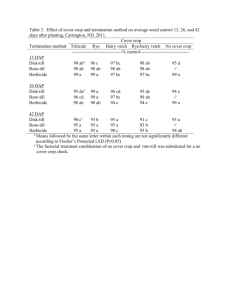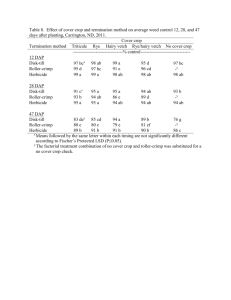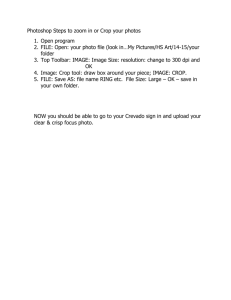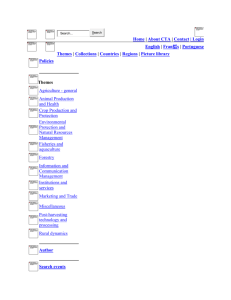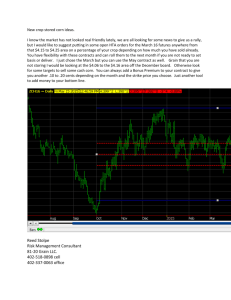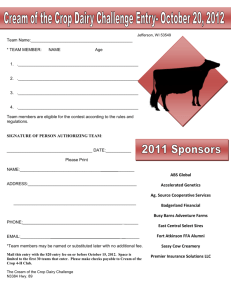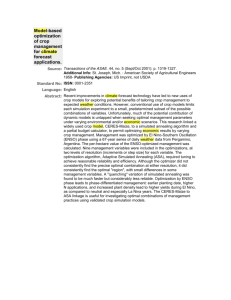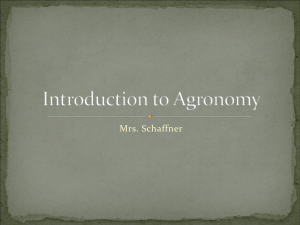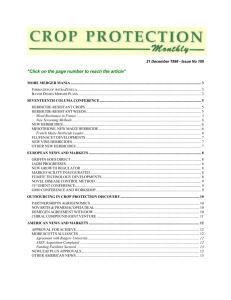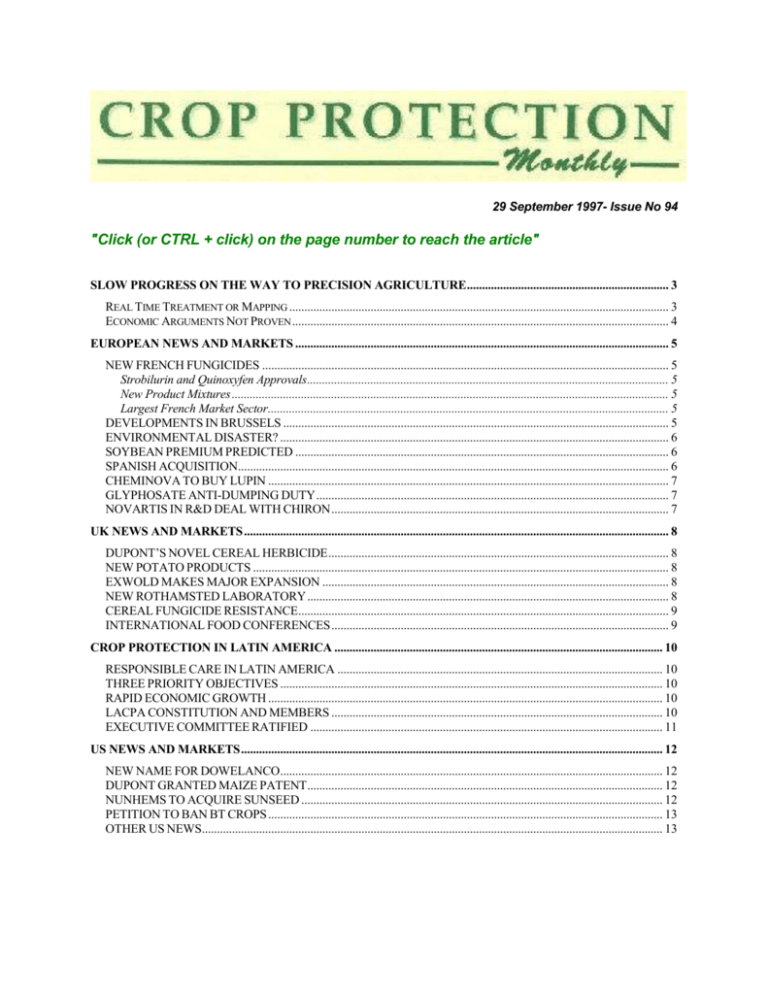
29 September 1997- Issue No 94
"Click (or CTRL + click) on the page number to reach the article"
SLOW PROGRESS ON THE WAY TO PRECISION AGRICULTURE ................................................................... 3
REAL TIME TREATMENT OR MAPPING .............................................................................................................................. 3
ECONOMIC ARGUMENTS NOT PROVEN ............................................................................................................................. 4
EUROPEAN NEWS AND MARKETS ............................................................................................................................ 5
NEW FRENCH FUNGICIDES ....................................................................................................................................... 5
Strobilurin and Quinoxyfen Approvals ........................................................................................................................ 5
New Product Mixtures ................................................................................................................................................. 5
Largest French Market Sector..................................................................................................................................... 5
DEVELOPMENTS IN BRUSSELS ................................................................................................................................ 5
ENVIRONMENTAL DISASTER? ................................................................................................................................. 6
SOYBEAN PREMIUM PREDICTED ............................................................................................................................ 6
SPANISH ACQUISITION............................................................................................................................................... 6
CHEMINOVA TO BUY LUPIN ..................................................................................................................................... 7
GLYPHOSATE ANTI-DUMPING DUTY ..................................................................................................................... 7
NOVARTIS IN R&D DEAL WITH CHIRON ................................................................................................................ 7
UK NEWS AND MARKETS ............................................................................................................................................. 8
DUPONT’S NOVEL CEREAL HERBICIDE ................................................................................................................. 8
NEW POTATO PRODUCTS .......................................................................................................................................... 8
EXWOLD MAKES MAJOR EXPANSION ................................................................................................................... 8
NEW ROTHAMSTED LABORATORY ........................................................................................................................ 8
CEREAL FUNGICIDE RESISTANCE........................................................................................................................... 9
INTERNATIONAL FOOD CONFERENCES ................................................................................................................ 9
CROP PROTECTION IN LATIN AMERICA ............................................................................................................. 10
RESPONSIBLE CARE IN LATIN AMERICA ............................................................................................................ 10
THREE PRIORITY OBJECTIVES ............................................................................................................................... 10
RAPID ECONOMIC GROWTH ................................................................................................................................... 10
LACPA CONSTITUTION AND MEMBERS .............................................................................................................. 10
EXECUTIVE COMMITTEE RATIFIED ..................................................................................................................... 11
US NEWS AND MARKETS ............................................................................................................................................ 12
NEW NAME FOR DOWELANCO............................................................................................................................... 12
DUPONT GRANTED MAIZE PATENT ...................................................................................................................... 12
NUNHEMS TO ACQUIRE SUNSEED ........................................................................................................................ 12
PETITION TO BAN BT CROPS ................................................................................................................................... 13
OTHER US NEWS......................................................................................................................................................... 13
2
OTHER NEWS THIS MONTH ...................................................................................................................................... 14
DUPONT IN RUSSIAN JOINT-VENTURE ................................................................................................................ 14
INDIA LOSES WTO CASE........................................................................................................................................... 14
UNITED NATIONS ADDS FIVE TO PIC .................................................................................................................... 14
AGREEMENT ON METHYL BROMIDE ................................................................................................................... 15
29 September 1997
© Market Scope Europe Ltd
www.crop-protection-monthly.co.uk
3
SLOW PROGRESS ON THE WAY TO PRECISION AGRICULTURE
At the 1st European Conference on Precision Agriculture held at Warwick University from 8-10 September,
practical examples of economic benefits from “spatially selective agriculture” were hard to find. About 400
delegates (66% from institutes, 30% industry, 4% farmers) representing 28 countries discussed a range of
disciplines from space imagery and software to agronomy. Most presentations concerned variations in yields
and soil nutrient status.
Although major advances in the technology are being made on both sides of the Atlantic, particularly in
measurement techniques and satellite imaging (GPS), there is still much uncertainty as to how the farmer can
benefit from knowledge gained in measuring variations within fields. Progress relating to crop protection is
behind that of soil nutrients, but Novartis and Rhône-Poulenc are known to be studying the opportunities in
some depth.
Chris Dawson, a leading UK-based consultant in precision agriculture, gave the opening plenary lecture on
Managing Spatial Variability. Emphasising the need to establish consistent protocols for sampling and
accuracy in measurement, his philosophy is “if you can measure it, you can manage it”. He cited an example
where mapping potato cyst nematode populations in one large field under a grid gave potential savings of
£7000 in nematicide costs. Dawson takes the view that nematodes and weeds are the most appropriate
targets as fungus and insect attacks are too mobile.
Real Time Treatment or Mapping
Varying herbicide applications across the field area can be achieved from instant measurement of weed
populations linked to the spraying operation. This “real time” approach does not require locational mapping,
but the technology is not very developed. A paper from Ms Vrindts, Leuven University, outlined work to
distinguish between crop, weed and soil using optical reflectance. Indications are that near infra-red light will
prove the most effective.
From laboratory trials there is already good correlation between reflectance properties and species. Sugar
beet, maize and potatoes can be separated with accuracies down to 1-2% and good separation has been
recorded with several important weed species. Variations in natural light quality and moisture on the leaves
are major problems. Developing weed maps using visual recording and GPS systems is already possible and
software for weed mapping is commercially available.
A poster at Warwick and an open day at Silsoe Research Institute on 11 September featured the latest
developments in the concept of “patch spraying”. This is based on a sprayer design that switches herbicide
application on or off, or varies the dose rate, according to weed intensity. Professor Paul Miller has been
leading an engineering design programme at Silsoe aimed at perfecting the patch spraying concept for
several years. When asked whether he sees mapping or real time weed control as the way forward he told
CPM, “I am a mapping man - for the simple reason that it will be easier for the farmer to plan and cost his
herbicide needs.”
Silsoe has now moved on from a novel direct injection system to a simpler system whereby conventional
sprayers can be converted as a ‘retro-fit’. Paul Miller commented, “In some ways we have moved backwards,
but we see this as having a better chance of making commercial progress”. The new system relies on
applying a constant spray dilution at different volume rates, achieved by a combination of nozzle pressure
change and switching to nozzles with different orifices.
29 September 1997
© Market Scope Europe Ltd
www.crop-protection-monthly.co.uk
4
The electronically controlled multiple nozzle system allows smooth variation in flow and dose rate and, where
needed, the sprayer can be shut off completely. It is being developed at Silsoe in collaboration with Micron
Sprayers Ltd, Bromyard, UK. Most field work has been done with liquid fertilisers, with herbicide trials planned
for 1998. Commercial models could be available in one to two years time.
Economic Arguments Not Proven
Concluding the Warwick conference, Silsoe director Professor Brian Legg commented “If the technology is
not taken up in the next 6-7 years, funding will dry up and manufacturers will lose interest”. It is still not proven
“whether precision agriculture is genuinely better or more economic than uniform treatments”. Robust
systems are required and “research needs broadening beyond combinable crops”.
The advent of precision agriculture with more accurate product targeting will inevitably lead to lower herbicide
and growth regulator sales. On a positive note for the pesticide industry, some environmental problems will
be solved and its public image should improve.
29 September 1997
© Market Scope Europe Ltd
www.crop-protection-monthly.co.uk
5
European News and Markets
NEW FRENCH FUNGICIDES
The French fungicide famine is finally over, with a number of new products with new active ingredients
approved or soon to receive approval. This will give French farmers the chance to catch up on some of their
European counterparts, especially the Germans, who have benefited from using comparable products for two
seasons already (CPM, April 1996). Earlier this year, Rhône-Poulenc’s herbicide, flurtamone, became the
first new active ingredient to be approved in France since 1993 (April CPM). The latest approvals suggest
the ‘logjam’ is starting to clear.
Strobilurin and Quinoxyfen Approvals
BASF received approval for Ogam (125 g/l kresoxim-methyl + 125 g/l epoxiconazole) in June for use on all
main cereal types at 1.0-1.2 litres/hectare. It just beat Zeneca, which has now just obtained registration for
Amistar (250 g/l azoxystrobin) and Amistar Pro (100 g/l azoxystrobin + 280 g/l fenpropimorph) on wheat and
barley. DowElanco is introducing Fortress (500 g/l quinoxyfen), which was recently launched in the UK (April
CPM), for use on wheat and barley. Bayer is also expecting to introduce spiroxamine in 1998.
New Product Mixtures
As well as the new active ingredients, a large number of new product mixtures are coming on to the market.
Sipcam Phyteurop is launching two new tetraconazole mixtures with fenpropimorph and prochloraz, under
the names Aramir and Bonanza respectively. Rhône-Poulenc is also introducing mixtures of tetraconazole
with fenpropimorph and chlorothalonil, as Fief and Arum respectively. Rhône-Poulenc has also taken over
distribution of Tango Duo (epoxiconazole + tridemorph) from BASF.
Bayer and the Novartis sales organisation, Parthéna, are each introducing new mixtures of propiconazole
and tebuconazole as Cosinus and Cogito. Another Novartis sales team, Evolya (June CPM) is launching
Koara (propiconazole + cyprodinil), Armure (propiconazole + difenoconazole) and Diapazon (propiconazole
+ tebuconazole + fenpropidin).
Largest French Market Sector
Cereal fungicides are the largest sector of the French crop protection market, valued at well over US$400
million, with nearly 14 million superdeveloped hectares treated in 1996. Products based on BASF’s
epoxiconazole currently dominate the market, accounting for over 25% of the area treated. This figure will
probably rise further in 1997 with the addition of Ogam. There is likely to be a switch towards earlier
treatments with the products based on the new ‘ais. These are likely to take a large part of the cereal
fungicide market in the 1997/98 season.
DEVELOPMENTS IN BRUSSELS
The European Commission announced this month that it intends to force Austria, Luxembourg and Italy to lift
their national bans on genetically modified maize imports. Luxembourg, which currently holds the presidency
of the European Union, is to resist the Commission’s efforts, according its Health Minister, Johnny Lahure,
and will take its fight to the European Court of Justice if necessary. Lahure views the maize as a public
health risk.
29 September 1997
© Market Scope Europe Ltd
www.crop-protection-monthly.co.uk
6
Speaking at a meeting on Novel Food in Brussels on 19 September (organised by the biotechnology trade
association, Europa-Bio, and AgrEvo), Agriculture Commissioner, Franz Fischler, commented that
“biotechnology is a key technology for the future of Europe” which “can bring significant advantages to
consumers and the environment”. He criticised poor communication from both industry and the media as
contributing to ungrounded public fears and concerns.
Fischler conceded that there were faults with the current registration procedure for transgenic plants in
Europe and that these would be dealt with when reforms were introduced. He also felt segregation of
transgenic products was neither useful nor practical. Fischler commented that whenever genetically modified
organisms (GMOs) could be detected in food products, they ought to be clearly labelled and added, “if we
don't respect the consumer's requirements, we will not be able to sell our products.”
Six days later, on 25 September, the European Commission announced that foodstuffs produced from
genetically modified soybeans or maize would indeed have to be labelled as such from 1 November, under
the EU’s Novel Foods Regulation. This will also apply to any products which were on the market before the
regulation came into effect.
ENVIRONMENTAL DISASTER?
In a speech in Salzburg this month, Robert Horsch, general manager of Monsanto's Agracetus unit, said that
“ignoring advances in biotechnology could lead to environmental disaster”. He argued that biotechnology
offered the chance to produce more food on the same area of land and reduce food loss after harvesting.
According to Horsch, more than 56 crops altered by biotechnology have so far been tested in 34 countries,
with over 12 million hectares of genetically modified crops planted this year, up from 2.5 million ha in 1996.
SOYBEAN PREMIUM PREDICTED
European importers of US non-transgenic soybeans will be paying a premium of around 15% within a few
years, according to David Wheat of the Bowditch Group at a food industry conference in Brussels this month.
He expects genetically modified soybeans to become the accepted norm within a few years.
According to Mr Wheat, US farmers cannot afford to ignore transgenics, as in a commodity business costs
have to be minimised. He estimates that US growers can save at least $13 a hectare with Roundup Ready
varieties. David Wheat regards segregation of transgenic material as practicable, but with inevitable extra
costs attached. Based on cost analysis on other specialty crops in the USA that are kept separate from the
main supply chain, he estimates that the premium would be $24-$38 per tonne, compared with the current
European prices for US soybeans of about $270 per tonne.
SPANISH ACQUISITION
Makhteshim-Agan has purchased the remaining 51% of Aragonesas Agro SA, Madrid, for US$10.5 million
from Energia e Industrias Aragonesas. The Israeli company acquired a 49% stake last year for $31 million,
with an option to acquire the rest the Spanish company within three years (CPM, August 1996).
Aragonesas, which has 5-6% of the Spanish crop protection market, recorded sales of about $35 million in
1996. About 30% of its sales come from Makhteshim-Agan products. Spain is the fourth biggest market for
the Israeli concern, after the USA, France and Brazil.
29 September 1997
© Market Scope Europe Ltd
www.crop-protection-monthly.co.uk
7
CHEMINOVA TO BUY LUPIN
Following negotiations started early this year, the Danish generics producer, Cheminova Agro A/S, Lemvig,
has now signed a Letter of Intent for the acquisition of the Indian company, Lupin Agrochemicals Ltd.
According to the company, Cheminova Agro’s investment for the take-over, together with some immediate
improvements and expansions, is expected to total about 120 million Danish Kroner (US$ 17.7 million).
Lupin Agrochemicals was established in 1986 and is part of the Lupin Group, which will now focus on its
pharmaceutical activities. It has a head office in Mumbai (formerly Bombay), and a manufacturing site in an
area north of the city reserved for the chemical industry, with its own incineration plant and biological wastewater treatment. Lupin is a major producer of the insecticide, monocrotophos, and also manufactures three
other organophosphorus insecticides, namely acephate, chlorpyrifos and quinalphos. A wide range of other
products are also formulated and packed at its plant.
Lupin Agrochemicals is amongst the top ten Indian crop protection companies with about 5% share of the
domestic market (May CPM). In its last financial year, to 31 March 1997, it recorded turnover of about $33.2
million, with pre-tax profits of $1.5 million. Lupin will give Cheminova access to the Indian market and could
also act as a bridgehead for developing further business in the rest of Asia. Cheminova is planning to
expand and modernise the development laboratories at Lupin’s factory to supplement its process
development work at laboratory and pilot plant scale.
Cheminova Agro’s parent company, Cheminova Holding A/S, acquired full control of the sprayer company,
Hardi International A/S earlier this year (February CPM). It also narrowly missed out on a pesticide
acquisition opportunity in Brazil last year and is expected to continue looking for further take-over prospects.
GLYPHOSATE ANTI-DUMPING DUTY
The European Commission has imposed a provisional anti-dumping duty of 21.1% on imports of glyphosate
from China this month. The move follows an investigation instigated in October 1995 after a complaint was
made by Monsanto’s European office in Brussels with support from the Danish manufacturer, Cheminova
Agro A/S. The regulation will apply for a period of six months, unless the Commission decides to extend it or
the Council of Ministers imposes a more definitive ruling.
NOVARTIS IN R&D DEAL WITH CHIRON
Novartis Crop Protection Ltd, Basel, has signed a three-year agreement with Chiron Technologies, part of
Chiron Corporation, for the supply of combinatorial chemistry libraries. Novartis will use the libraries to select
compounds with potential applications in crop protection and animal health. Under the agreement, Novartis
will support the chemical synthesis group at Chiron Technologies Pty Ltd, Melbourne, Australia.
The group will synthesise selected libraries using its patented Multipin technologies, which Novartis will
screen against its proprietary assays. Novartis will have the option for exclusive, world-wide licences to
active compounds and derivatives for crop protection and animal health use. Chiron will retain all rights to
compounds for other uses.
29 September 1997
© Market Scope Europe Ltd
www.crop-protection-monthly.co.uk
8
UK News and Markets
DUPONT’S NOVEL CEREAL HERBICIDE
DuPont is launching a new cereal herbicide in the UK this autumn, Lexus Class (flupyrsulfuron-methyl +
carfentrazone) which the company expects to set new standards for control of blackgrass, Alopecurus
myosuroides, and a wide range of broadleaf weeds in winter wheat, winter oats, rye and triticale. Lexus
Class has both translocated foliar and root activity, with particularly rapid contact action against cleavers,
Galium aparine, and speedwells, Veronica spp.
The new herbicide will be available in 60 gm water-soluble mini-sachets, sufficient to treat one hectare. Once
used, the outer packaging can be disposed of as household waste. With its new mode of action, it should
prove a welcome addition to the limited range of products available for blackgrass control.
NEW POTATO PRODUCTS
Rhône-Poulenc’s fungicide, Fungazil 100 SL (imazalil) has just received full approval for use in stored ware
and processing potatoes for control of silver scurf, skin spot, gangrene and dry rot. Already approved for
seed potatoes, it gives good control of thiabendazole-resistant strains. RP’s molluscicide, Genesis
(thiodicarb) has also been approved for potato use.
Also this autumn, Rhône-Poulenc is launching a new enclosed chemical transfer system, Temik Surefill, for
potato and sugar beet growers to ensure safer application of granular nematicides by reducing human
contact with them. The returnable, strengthened plastic container with grip bar couples to a new valve
system on an applicator and delivers 20 kg of granules of Temik 10G (aldicarb).
EXWOLD MAKES MAJOR EXPANSION
Formulation specialist, Exwold Technology Ltd, Billingham, Teesside, is to build a new fungicide extrusion
granule plant in Hartlepool, with a capacity of 3-4,000 tonnes per annum. Exwold currently employs 21 staff
at its Billingham plant and an additional 14 employees will be taken on for the new plant. The first product to
be formulated at Hartlepool will be Acrobat (dimethomorph), under contract for American Cyanamid. Exwold
has also recently agreed a contract with FMC’s European office in Brussels to formulate the company’s new
cereal herbicide, Affinity (50% isoproturon + 0.75% carfentrazone ethyl) at Billingham and a further contract
for this site is expected to be announced shortly. Affinity has been already launched in Switzerland and the
product is expected to be introduced to the UK and German markets shortly.
NEW ROTHAMSTED LABORATORY
IACR-Rothamsted held an open day on 1 September to celebrate the 10th anniversary of its Entomology and
Nematology Department. The occasion was also marked by the official opening by MAFF chief scientist, Dr
David Shannon, of a new, state-of-the-art Invertebrate Behaviour Laboratory.
The Department has an international reputation for its work on plant nematology, bee pollination and
diseases, monitoring insect populations and parasitoid conservation and manipulation. Its immunological
approaches to the diagnosis of cereal and potato cyst nematodes are currently being commercially evaluated
and Rothamsted is also involved in an EU programme to find a replacement for methyl bromide. One of the
challenges facing Rothamsted is keeping skilled personnel, as over 60% of researchers are on contracts of
three years or less.
29 September 1997
© Market Scope Europe Ltd
www.crop-protection-monthly.co.uk
9
A key project is sustainable long-term control of nematodes. In the UK, there are two main nematode pests,
Globodera pallida and G Rostochiensis. The latter has been well controlled by oxamyl and other products
over many years, but this has led to the preponderance of G pallida, which is more difficult to control.
Rothamsted is currently receiving support from DowElanco for a study of nematode distribution in the UK. It
is also developing nematode-resistant transgenic potato lines (with snowdrop lectin and protease inhibitors)
and biological control methods.
CEREAL FUNGICIDE RESISTANCE
Widespread resistance of barley leaf blotch, Rhynchosporium secalis, to benzimidazole fungicides has been
identified for the first time in the UK, as well as increased resistance to some DMI products. The findings are
revealed in Fungicide Resistance in Cereal Pathogens (1991-1996) published by the Home-Grown Cereals
Authority, from a five-year project co-ordinated by Dr Derek Hollomon, IACR-Long Ashton. The study states
that “resistance has so far caused few practical problems in cereal disease control” and dismisses reports
that eyespot has become resistant to prochloraz as unsubstantiated.
INTERNATIONAL FOOD CONFERENCES
Late this month, Oxford hosted The Future Agenda for Organic Trade, organised by the International
Federation of Organic Agriculture Movements; and nearly 200 delegates from 11 countries attended Crop
Protection & Food Quality in Canterbury, jointly organised by BCPC and ANPP. CPM will report on both
these conferences in next month’s edition.
29 September 1997
© Market Scope Europe Ltd
www.crop-protection-monthly.co.uk
10
Crop Protection in Latin America
RESPONSIBLE CARE IN LATIN AMERICA
This was the main theme for the first annual meeting of the Latin American Crop Protection Association
(LACPA), held in Mexico City from 22-25 September. Jean L Vayssier, President of LACPA, welcomed
delegates from 18 Latin American national trade associations, three regional federations, and 11 international
pesticide companies. LACPA was established on 13 May 1997 and is legally constituted in Montevideo,
Uruguay. It is one of the six regional associations which form part of the Global Crop Protection Federation
(GCPF), Brussels (formerly GIFAP). Special guests who attended included Dr J Wulff, Dr J Hagaman and Mr
K P Vlahodimos, GCPF’s President, Vice-President and Director General respectively, and Dr F Gurría from
Mexico’s Environment Ministry.
THREE PRIORITY OBJECTIVES
LACPA's commitment to responsible care is shown in three GCPF objectives. The first is compliance with
the FAO International Code of Conduct on the Distribution and Usage of Pesticides. The second is the Safe
Use Initiative, implemented through workshops and training programmes targeted at those directly involved in
product distribution and application. In Guatemala there is a GCPF pilot project which has been a base for
developing experience and skills for use elsewhere. The Brazilian industry association, ANDEF, and the
University of Viscosa have a project for post-graduate courses in crop protection sciences.
The third project involves management of empty pesticide containers. More than 50% are made of
polypropylene and LACPA is developing programmes for disposal, following triple rinsing. This involves
collection centres where the material can be shrunk or crushed, after which it is recycled or used as an
energy source in cement kilns. Delegates viewed a video about Safe Use Projects showing programmes in
the region and also the pilot container management initiatives in Brazil, Guatemala and Mexico.
RAPID ECONOMIC GROWTH
Latin American markets are still growing at a very rapid rate. This growth is linked to the revival of their
economies, due to free trade agreements (Mercosur, Pacto Andino and the Central American countries)
greater democracy, privatisation initiatives, tax reform and currency exchange stability. The agricultural sector
has also benefited from the world-wide increase in food demand. In 1996, the Latin American crop protection
market reached US$3.9 billion (ex-works sales) and in 1997 this figure will top $4 billion. Brazil is easily the
largest economy in the region and its sales of crop protection products are expected to exceed $2 billion this
year.
LACPA CONSTITUTION AND MEMBERS
LACPA comprises an Executive Committee, as well as Regulatory, Safe Use, Container Management and
Communications Committees, set up according to GCPF guidelines. These provide support for the national
associations and regional federations.
29 September 1997
© Market Scope Europe Ltd
www.crop-protection-monthly.co.uk
11
LACPA’s members are: FICASUR (Cono Sur Agrochemical Industry and Trade Federation), which takes in
Argentina, Brazil, Chile, Paraguay and Uruguay, based in Montevideo and headed by Daniel Vincent;
FESANDINA (Andean Federation of Crop Protection Enterprises), which includes Bolivia, Colombia,
Ecuador, Peru and Venezuela, based in Lima and headed by Javier García; and FECCOPIA (Central
American and Caribbean Federation), which includes Belize, Costa Rica, Dominican Republic, El Salvador,
Guatemala, Honduras, Nicaragua and Panama, headquartered in Guatemala under Edmundo Girón; and the
meeting host and Mexico’s national association, AMIFAC (Mexican Phytosanitary Industry Association),
headed by Wilhelm Joos, which does not belong to any regional federation.
EXECUTIVE COMMITTEE RATIFIED
The LACPA Executive Committee was ratified and comprises: Jean L Vayssier of Bayer Latin America (LA);
Alfredo Ruiz, DowElanco Andean Countries; Bernd Kupferschmied, Novartis Central America; David Giffin,
Cyanamid Brazil; Jean Stranges, Rhône-Poulenc LA; Carlos Buzio, Monsanto LA; Enrico Fantechi, Zeneca
LA; Christiano Burmeister, BASF Brazil; Mario Carincote, AgrEvo LA; Alvaro Peon, DuPont Mexico; Leon
André, FMC; Dirk Epp, CASAFE, Argentina; Cristiano Simon; ANDEF, Brazil, Alfredo Ruiz, ANDI; Luis Villa,
AMIFAC; and, as Regional Co-ordinator for Latin America, Freddy Fernández, San José, Costa Rica.
LACPA approved a budget and agreed to hold a Communication Workshop in Costa Rica in January 1998.
At the end of the meeting, Dr Wulff commented that the Safe Use Initiative, started by GCPF in the region in
1991, was “showing progressive results, and has served as a model to many other countries that have
initiated their own projects”. Currently there are 17 projects in Latin America. Dr Wulff congratulated LACPA
for “strengthening its representation in Latin America” but cautioned that there was “still a long and
demanding way ahead”.
29 September 1997
© Market Scope Europe Ltd
www.crop-protection-monthly.co.uk
12
US News and Markets
NEW NAME FOR DOWELANCO
As of 1 January 1998, DowElanco will be renamed Dow AgroSciences, reflecting its new status as a whollyowned subsidiary of The Dow Chemical Company. William Stavropoulos, Dow’s president and CEO,
predicts that world agriculture will change dramatically over the next two decade and that Dow AgroSciences
will help “lead efforts to initiate, shape and direct this transformation".
DowElanco has set and achieved its goal of commercialising one significant new product in a major global
market each year. Two have been launched this year, quinoxyfen in Europe and spinosad in the USA.
Dow has revealed that it has got acceptances for 87.2% of Sentrachem Ltd's shares by September 15. Its
offer for the South African company is open until October 6 but can be extended (August CPM).
DUPONT GRANTED MAIZE PATENT
DuPont has been granted a US patent this month for its high-oil maize production system. The maize has
been grown on 400,000 hectares in the USA this season and the company expects the area to double next
year (August CPM). The Optimum maize, produced by traditional crossbreeding, contains nearly twice as
much oil as current varieties and offers poultry and pig farmers a cheaper source of feed. It is the forerunner
for a number of transgenic maize developments from DuPont. However, these will require FDA approval,
which may take two years.
DuPont already has FDA approval for transgenic soybeans with modified oil content and is aiming to secure
registration in Europe and Japan. Over 4,000 hectares of the soybeans have been planted this year, with
over 40,000 ha expected in 1998. The soybeans, which have a much higher level of oleic acid than normal
varieties, are regarded as a potential replacement for hydrogenated vegetable oil and will be test marketed
this autumn as frying oil by McDonald's. DuPont anticipates that its sales from "quality grains" will double
every year for the next four to five years, exceeding $200 million in 1999.
NUNHEMS TO ACQUIRE SUNSEED
Nunza BV, the holding company of the Nunhems Group, has signed an agreement to acquire the hybrid
vegetable seed company, Sunseed Corporation, Morgan Hill, California, from a group of shareholders which
includes Pioneer Hi-Bred International. As well as a good position in North American markets, Sunseeds
employs 300 people and has a subsidiary in India and joint ventures in China and Chile. The company
enjoys a leading position in US carrot and onion seed markets and is well-placed in tomato, melon,
watermelon and cucumbers. Sunseeds acquired Pioneer Vegetable Genetics in 1996.
Established in 1916, Nunhems now employs 450 staff and is part of AgrEvo, having previously been acquired
by Hoechst. The Sunseed acquisition will make Nunhems the fourth largest vegetable seed company in the
world and strengthen its position in North American and Asia. Sunseeds will operate as an independent profit
centre for the immediate future.
29 September 1997
© Market Scope Europe Ltd
www.crop-protection-monthly.co.uk
13
PETITION TO BAN BT CROPS
Greenpeace has allied itself with the organic farming fraternity and other groups to submit a petition to the US
Environmental Protection Agency calling for a ban on Bt crops. The groups claim that Bt crops will increase
pest resistance to Bacillus thuringiensis, which many organic farmers spray on their crops. EPA has 90 days
to respond to the petition, a first step in filing litigation. The agency acknowledges that increased pest
resistance as a result of Bt crops is a real danger, but believes it has adequate resistance management
plans, including a requirement to plant “refuge areas” with non-Bt crops. However, these plans are to be
reviewed in response to the petition.
OTHER US NEWS
DeKalb expects to market enough seed to plant about 400,000 hectares of Roundup Ready maize next
spring. DeKalb is likely to be the only company marketing the seed in 1998, although others will follow in
1999. The company has an agreement with Monsanto permitting it to license the technology to other seed
companies. About four million hectares of Roundup Ready soybeans have been planted in the USA this
year, over 11% of the total maize acreage.
The US Department of Agriculture is creating an Office of Pest Management to compile data on pesticide use
and residues in food to help in the registration of minor use pesticides. It will work closely with the
Environmental Protection Agency, which will be forming a Minor Use Program Team to co-operate with
growers and crop protection firms.
Florida’s $20 million programme to protect its fruit and vegetables from the Medfly has finished after over four
months. It looks to have been a success, although the worst affected areas will remain in quarantine until
November.
29 September 1997
© Market Scope Europe Ltd
www.crop-protection-monthly.co.uk
14
Other News This Month
DUPONT IN RUSSIAN JOINT-VENTURE
DuPont and A O Khimprom, Novocheboksarsk, have disclosed plans this month to form a joint-venture
company, DuPont Khimprom, to produce and market crop protection products for agricultural markets in
Russia. The operation will be developed in a number of phases with an initial investment of about US$10
million to create a crop protection manufacturing business for the Russian market. The jv, expected to be
60% owned by DuPont, 40% by Khimprom, will be primarily involved in the production of sulfonylurea
herbicides. The Russian market is estimated to be worth a modest $200 million today, but is expected to
grow to $1,000 million within the next 5-10 years.
DuPont already has a number of significant ventures planned and operating in Russia, including a jv through
its oil company, Conoco. A O Khimprom, located about 650 km east of Moscow, is one of the leading
chemical producers in Russia, manufacturing dyes, surfactants, detergents, polymers and pesticides.
Khimprom’s plant at Ufa used to be the world’s biggest producer of 2,4-D, with a capacity of over 40,000
tonnes per annum, until it ran into environmental problems. It also produces lenacil, methyl parathion and
trichlorfon.
INDIA LOSES WTO CASE
The United States has won a World Trade Organisation action against India for its failure to provide
intellectual property rights protection as required by a WTO agreement. A WTO panel has supported a US
claim that India failed to implement a system to receive patent applications and did not implement an
exclusive marketing rights system. This was required by the WTO Agreement on Trade-Related Aspects of
Intellectual Property Rights (TRIPS) for developing countries that did not provide patent protection for
pharmaceutical and agricultural chemicals. TRIPS allowed these countries 10 years to establish protection if
they created appropriate systems in the interim.
The Indian government is to appeal against the verdict and is setting up a panel to develop a national
consensus on intellectual property rights. India was able to meet patent requirements when it joined WTO in
1995 by means of a presidential decree which temporarily protected products. The decree later expired and
legislation replacing it was stalled due to opposition in the upper house of parliament. The Indian government
is awaiting final WTO judgement before reintroducing a new bill on patents. Exports of bulk drugs and
pharmaceuticals from India topped US$1,000 million last year.
UNITED NATIONS ADDS FIVE TO PIC
The United Nations Food and Agriculture Organisation and the UN Environment Programme announced this
month in a joint statement that five hazardous organophosphate insecticides are to be added to an
international list of substances which should not be exported without the consent of importing countries. The
five are methamidophos, methyl parathion, monocrotophos, parathion and phosphamidon. The UN claims
that product formulations pose a considerable risk to the health of many small farmers through skin
absorption and that consumers can also be at risk of acute poisoning from vegetables treated with them
shortly before harvest.
The five insecticides are now subject to the Prior Informed Consent (PIC) procedure, whereby participating
countries are alerted to the dangers of pesticides and can then decide whether to import them or not.
Negotiations are also underway to change the voluntary PIC procedure into a legally binding convention.
29 September 1997
© Market Scope Europe Ltd
www.crop-protection-monthly.co.uk
15
AGREEMENT ON METHYL BROMIDE
A compromise agreement was reached on the phasing-out of methyl bromide this month by the 150 or so
signatories to the 1987 Montreal Protocol on Ozone-Depleting Substances. Industrialised countries will ban
methyl bromide by the end of 2004, developing countries by the end of 2014 (June CPM).
Published by: Market Scope Europe Ltd
ISSN 1366-5634
Website: http://www.crop-protection-monthly.co.uk
Editor: Brian R. Hicks
E-mail: brianralphhicks@aol.com
Contributors: Judith Ainsley, Dr Rob Bryant, Godfrey Hicks, Fausto Montoya, Bruce Knight and Elaine Warrell
Editorial and Subscription Enquiries to:Crop Protection Monthly
6, Torcross Grove, Calcot
Reading Berkshire RG31 7AT England
Tel: +44 (0) 118 941 7539 Fax: +44 (0) 118 942 0014
E-mail: CPMSubscriptions@aol.com
Published 12 times a year. All rights reserved. No part of this publication may be reproduced, stored in a retrieval system or transmitted in any form or by any
means - electronic, mechanical, photocopying, recording or otherwise - without the prior written permission of the Copyright owner. Any prices indicated by
Market Scope Europe (MSE) in this publication represent only an approximate evaluation based upon such dealings (if any) in those materials as may have
been disclosed to MSE prior to publication. Whilst every effort is made to ensure that such prices are representative, and that the analysis, comment and
opinion in the text is accurate, MSE cannot accept any liability whatsoever to any person choosing to rely upon the prices evaluated or views expressed by
MSE, including liability for negligence.
29 September 1997
© Market Scope Europe Ltd
www.crop-protection-monthly.co.uk

